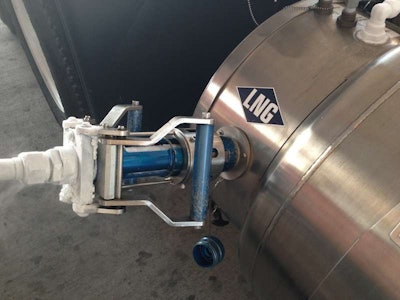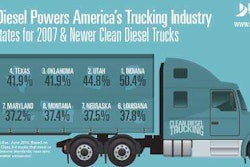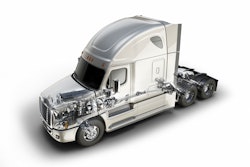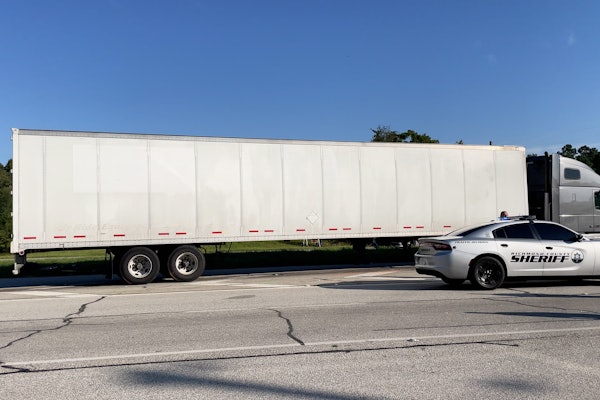 As diesel engines become more fuel efficient and greener, the future and role of alt fuels like LNG in trucking becomes even cloudier.
As diesel engines become more fuel efficient and greener, the future and role of alt fuels like LNG in trucking becomes even cloudier.The diesel engine has undergone such an evolution that Charles Darwin would most assuredly be driving one. Just think back 20 or so years to the black smoke belching behemoths that have been under fire from Washington lawmakers ever since.
Trucking is a fairly simple concept: you move something from Point A to Point B in Time Frame X and you are paid $Y. However, the pieces that make up that puzzle are obviously far more complicated as fleets and drivers scramble to catch up with persistent legislations and mandates.
With respect to hours of service and other FMCSA regs, emissions have arguably had the biggest impact on the truck itself. From the design of the truck and engine to the chemistry of the fuels you put in them, “this ain’t your granddaddy’s industry.”
Natural gas’ place in trucking has yet to be defined, and clarity isn’t likely to come soon. Billed as a cheaper and greener alternative to diesel, fleets – on a large scale – have been slow to embrace a technology that requires tens of thousands of dollars in additional up front investment in tanks and fuel systems to save a few dollars at the pump.
Couple that with a diesel gallon equivalent ratio that interns at NASA don’t fully understand and a still-developing infrastructure. There is no doubt natural gas can and does work in certain applications, but its long-term viability across multiple applications is a work in progress.
When greenhouse gas emission standards began to tighten, diesel appeared to be on the ropes. Well, here we sit with stabilized (if not declining) diesel fuel prices, and increasingly efficient and ever-greener diesel trucks. And they’re only getting better.
Thursday, Detroit Diesel Corporation unveiled its new Integrated Detroit Powertrain (IDP) featuring the company’s DD15 engine, DT12 transmission and Detroit axles; yet another chip on the table in favor of diesel. David Hames, general manager of marketing and strategy for Daimler Trucks North America, says the launch of the IDP was the next step in the company’s quest to achieve a 5 percent fuel economy savings every two years. Hames says the IDP offers additional 5 to 7 percent fuel economy savings (depending on a fleet’s baseline) over the Cascadia Evolution, already a fuel efficient truck in its own right.
The IDP is a more efficient engine, paired with a smarter transmission, attached to more efficient axles and integrated with other more efficient technologies. It’s not reinventing the wheel; it’s simply refining it.
OEMs like Daimler, Volvo and others — who have each dumped millions of dollars into research and development of cleaner and better diesels — are getting some extraordinary results. These green diesel innovations aren’t cheap, either. The biggest negative about all this new technology is its impact on sticker price. And that is only being reaffirmed on the used market with record prices for used trucks.
But diesel technology is known. Fleets and techs are equipped to service them. They’re familiar with them. Fuel is easy to find. Parts are easy to find. Resale value and trade cycles are familiar. These trucks are in many ways a simpler way to do the same thing.
Many OEMs expect natural gas trucks to make up 10 percent of all truck sales by 2020. Trending sales data would suggest that is certainly a possibility. Most fleets are willing to consider changing fuel types, or they’re at least are willing to do the math on potential savings. However, every two years that decision gets a little more complicated.
From a diesel emissions standpoint, there’s not much work left to be done. With near-zero emissions already, the reasonable expectation is that the next hurdle for OEMs to clear is efficiency. With tons of engineering muscle behind aero, reducing drag and other developments, that work is well underway.
OEMs are also finding willing aftermarket partners with trailer tails, wheel covers, lower rolling resistance tires and an ever growing line of efficiency add-ons.
At the Mid America Trucking Show in Louisville, Ky. in March, Dr. Wolfgang Bernhardt, CEO of Daimler AG Trucks & Buses, said his alternative fuel of choice was diesel, and he further backed that play with the rollout of the IDP last week.
There is certainly a place for alternative fuels in the industry, but with each new generation of truck and diesel engine, the landscape changes. If Daimler – and even some of its competitors – can squeeze roughly 5 percent fuel economy every two years, how far off are we from the point where the math on determining the feasibility of an alternative fuel isn’t worth doing?











